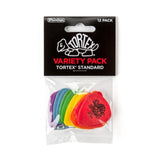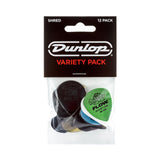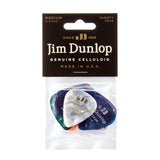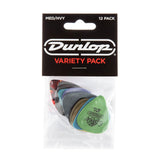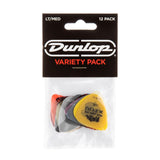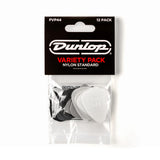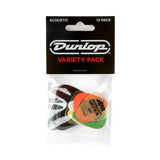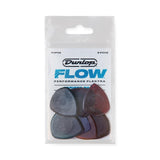Our guitar necks have been one of our best selling items over the years, offering a reasonably priced alternative to those big ticket items from the big name brands. Whilst a neck has a small effect on your tone, it plays a critical role in how your instrument feels, so it’s important to know what you’re going to be dealing with before you make a purchase. The neck profile, fretboard, and frets all affect how your neck performs, so we’ve put together this handy guide to help guide your hand.
Headstocks
The primary job of the headstock is to house the tuning machines, allowing you to adjust the tension of the strings and tune your guitar up and down. There are two distinct types of headstock, straight headstocks as you’d typically find on Fender models, and angled headstocks which are more commonly found on Gibson designs and their derivatives. Many a luthier will cite each type is better than the other, which is entirely debatable, but there are a few facts about both styles that are undeniable.
Straight headstocks are often used because they are easier to manufacture, retaining the strength required to be made out of one piece of wood which keeps costs down. To create the right break angle for the strings, you’ll often see a String Tree used to increase the angle of the strings and prevent them coming out of the nut during playing.
Angled headstocks arguably deliver better tone and tuning stability thanks to the acute angle, which also means no String Tree is required to help keep the strings in place. As you may have experienced, angled necks are susceptible to breaks when the instrument falls over or is dropped, and we’ve had many of these pass through our shop for repair.
If you’ve perused the guitar necks section of our website you may have noticed our headstock shapes have changed. Due to pressures from a certain large manufacturer of guitars, we were forced to redesign our headstocks to keep them as close to those original models as possible, whilst remaining entirely unique to Northwest Guitars.
Grade A North American Maple
Guitar necks are made of maple primarily because of it’s incredibly durable nature. On the Janka hardness test, North American Maple has a hardness of 1450, whereas Mahogany comes in between 800 to 900 depending on the species. What this means in terms of your guitar is that Maple necks are less susceptible to bending, requiring less truss rod adjustments over their lifetime.
A maple neck also makes for quicker string changes and is less sensitive to changes in humidity, meaning you don’t need to wait for the neck to settle back into its shape once you remove the strings, or wait as long for your guitar to adjust to a new environment.
We use Grade A North American Maple in our guitar necks and fretboards, which helps deliver impeccable playing performance that will also stand the test of time. Our Maple is light in colour with a fine texture that serves the dual purpose of being supremely shock resistant, whilst also being great to look at.
Fretboards
Modern day fretboards come in a huge variety of wood types and finishes, but for the most part they fall into two main categories, Rosewood or Maple.
Rosewood Fretboards
These are the most popular fretboards of all those found on guitar necks. Coming in varying shades of brown, it’s a loosely grained wood with a naturally oily texture, so it doesn’t require finishing unlike its Maple constructed cousin. The feel of a Rosewood fretboard is different to that of a Maple board thanks to its porous nature, they’ll feel less smooth than a Maple neck, but offer better control as the pores in the wood grip the string.
Maple fretboards
While less popular than Rosewood, they still have several characteristics that make them firm favourites for certain guitar players. Typically the neck and fretboard are all made from one piece of wood, but it’s the finish that defines the feel of a Maple neck. Our necks come in either Satin or Gloss, with Satin offering a texture more similar to that of Rosewood, whereas Gloss will feel slightly ‘sticky’, a common characteristic of Fender fretboards.
Choosing a fretboard is a very personal choice and not something you should jump at without trying first. If you’ve never played a Maple fretboard, you may find it feels completely different to that of a Rosewood equipped guitar, forcing you to adjust your playing style to compensate.
Neck Heel
Whilst the neck heel doesn’t offer any huge benefits to the playability of the neck, aside from accessing the highest frets on the fretboard, the shape of the heel is key to ensuring a good fit between the guitar neck and guitar body.
Our necks are all shaped to ensure maximum compatibility with genuine Fender bodies, making them perfect as replacements to existing guitar bodies, where you’re either not happy with the feel of the original neck or just fancy something different! Our necks are all compatible with MIA, MIJ, MIM, and Squier models, so you can vastly improve a beginner or mid range instrument, or replace like for like on something with heftier price tag.
Fret Size
Fret size has a small effect on your guitar neck’s playability, but not as much as you’d think. Most players tend to find that taller and wider frets feel easier to play, providing better sustain and being easier bend. Smaller frets provide more contact with the fretboard, whereas as taller frets require you to not have to press as hard because your fingers aren’t actually making contact with the fretboard itself. The downside of this is that it’s easier to go sharp with your notes due to pressing down too much pushing the notes out of tune.
Whilst certain players will swear by jumbo frets, or narrow tall frets, fret size is intrinsically linked to your neck profile, string gauge, and your guitar’s action when it comes to playing feel. So for that reason we decided to equip our guitar necks with the most popular fret size, medium jumbo. Medium jumbo provides the happy go between of easy bending, fast playability, whilst allowing you to feel the wood of your fretboard and not sound out of tune when pressing down hard on your strings.
Guitar Nuts
The guitar nut is one of those parts of the guitar that goes largely unnoticed compared to your tuners or bridge, but it plays an important part in ensuring your guitar plays well and stays in tune. That’s why we use bone nuts on all of our guitar necks, as they offer the best characteristics thanks to their solid and dense material. Bone nuts deliver fantastic resonance and sustain and are supremely strong, allowing them to put up with a tonne of playing abuse. Our nuts aren’t glued in, in case you need to make adjustments when the guitar neck reaches you.
If you want to learn more about Guitar Nuts then you can check out Part 3 of our Guitar Setup Guide.
Neck Profile
Neck profile could have a whole article itself written on it due to the raft of different varieties available. The neck profile doesn’t affect your tone, but it will drastically change the feel of the neck and how it reacts to your playing style. More so than any other aspect of the neck, the profile will impact playing feel. Neck profiles are denoted by letters that refer to the shape of the neck between the nut and the heel transition, a tradition that started when Fender first started manufacturing guitars.
'C' necks are the most common, coming in a standard semi-circle shape that will feel instantly recognisable to the majority of guitar players. Next up is the 'U' profile, which is again semi circular, but with longer vertical shoulders that result in a deeper shape. A 'V' profile neck is a rarer breed, and will not suit every playing style, but is the go to for the majority of Blues guitar players, especially those who like to have their thumb over the top of the fretboard. Lastly of the standard shapes we have 'D' profile, wider than a 'C' shaped neck and flatter on the bottom, which makes it feel thinner. The flatter bottom makes the neck feel faster, particularly on the treble strings.
Since the majority of guitars feature Modern C shape neck profiles, that’s what the majority of our own necks come as. We do have a select few D and V profiles however, to account for the specific tastes of guitarists but in our opinion the C shape neck is the most usable in a variety of styles, making it the best choice for the majority of guitarists. If you do want a D or V profile neck, we’d recommend playing one first before you make a purchase to ensure it's going to match your playing style.
Quality Checks
Before any of our necks can leave our warehouse they're given a six point inspection to ensure it reaches you in optimum condition. Our staff, who are all guitarists themselves, will scrutinise every aspect of the neck to ensure it meets the standards required to leave the warehouse and make its way to a new home. When inspecting a neck we ask the following questions:
- Are there any cracks, obvious or hairline?
- Is the finish is pristine and the gloss evenly applied?
- Is the nut properly cut and does it fit snugly in the slot?
- Is the neck straight? Can we see any warping or deformation?
- Are there are sharp fret edges, or damage to the frets themselves?
- And lastly is the neck wood free from major cosmetic imperfections?
Only once all of these checks are complete is the neck carefully packaged and sent on its way.
In Conclusion
So there you have it, everything you ever wanted to know about Northwest Guitar necks! Hopefully his guide helps take the guesswork out of purchasing a guitar neck, or at the very least allows you to glean some new information on necks you didn’t know previously. If you do need further information on buying a replacement guitar neck, then feel free to get in touch with us and ask away!
You can see all of our Guitar Necks here.
Learn More
Get your guitar in it’s best playing condition with our Guitar Setup Guide.
Learn more on neck related guitar gear with our Kluson Tuners Guide.
Our Guitar Bridges Guide offers more nuggets of knowledge on guitar hardware.



















